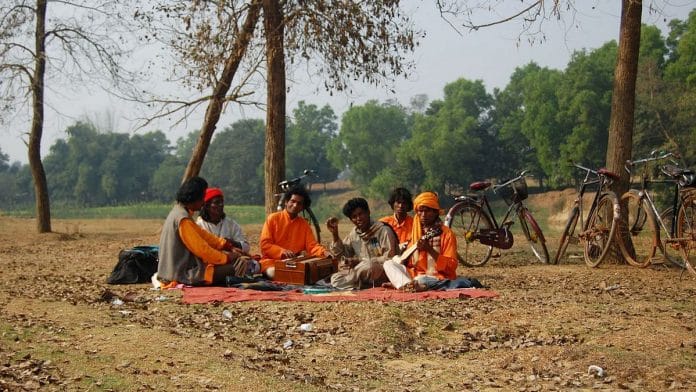New Delhi: Bangladesh has been witnessing a wave of arrests, attacks, and intimidation against Baul singers—the historic wandering mystic minstrels from rural West Bengal and Bangladesh. The latest to have been arrested is a prominent artist, Abul Sarkar, who was picked up from Manikganj earlier in November. The sudden escalation has triggered protests in Dhaka, concern among rights groups, and fears that a unique syncretic tradition is being pushed to the margins.
What is Baul music? Who are the singers, and what is their spiritual practice, lifestyle, musical tradition, and cultural significance?
What is Baul music?
Bauls are mystic folk musicians whose philosophy blends elements of Hindu Vaishnavism and Sufi Islam. Their songs—recognised by UNESCO as an Intangible Cultural Heritage of Humanity—focus on inner spirituality, humanism, and rejection of rigid religious orthodoxy. For centuries, Bauls have been celebrated across Bengal—from cities to village fairs to riverside gatherings. Lalon Shah, also known as Lalon Fakir, occupies a special place in the hearts of Bengalis.
Fakir is considered an icon in Bengali culture. Though he had no formal education, he composed more than 2,000 songs in simple yet profound language. He established a spiritual institute, the Lalon Akhra in Cheuriya, Bangladesh, and his teachings have influenced many figures, including Rabindranath Tagore. In 2004, a BBC poll asked its listeners to vote for the “Greatest Bengali of all time”, and Lalon came in 12th.
Tagore famously said that Baul philosophy represented “the heart of Bengal”.
The term ‘Baul’ can be roughly translated to ‘mad’ or ‘eccentric’, and the community’s songs convey its philosophy through music. The tunes—part of an oral tradition passed down through generations—use metaphors to teach spiritual concepts such as self-realisation and the search for the divine. Historically, these songs were passed from master to disciple and were never written down.
One of the most common metaphors used in Baul songs is the body as a temple where god resides, and meditation as an internal act of prayer.
Also read: What is bamboo scaffolding? Hong Kong’s deadliest fire in 100 years was made worse by it
Blend of Hindu, Sufi influences
Baul spiritual practice involves a unique blend of Hindu, Tantric, and Sufi influences. They are known for rejecting organised religion, the caste system, and rigid rituals, instead promoting only love.
The songs, accompanied by dances, are not just performances but a form of spiritual practice used to generate internal energy and achieve a state of inner stillness and transformation.
Traditionally, Bauls travel from village to village, singing at fairs, akhras (spiritual communes), riverbanks, and homes in exchange for food, shelter, or small donations. They embrace simplicity and believe that material possessions hold little value. Their lives are focused on spiritual liberation, and not on societal norms.
Bauls often live communally. The women—known as Baulinis—have historically played a strong role, though they remain less visible.
Most of these singers wear simple, loose-fitting clothing, with the specific colour and style depending on their tradition: saffron-colored tunics for Hindu Bauls and plain white attire for Muslim Bauls. For both men and women, the attire often includes a long, unstitched outer garment called an ‘Alkhalla’ with a dhoti.
Also read: Why Nepal’s new Rs 100 banknote has reignited India-Nepal border dispute
A dual reality
The cultural significance of Bauls lies in their unique, unorthodox devotional tradition, their influential folk music and poetry, and their role as mystics who challenge social and religious conventions.
At a time when the world is seeing increasing religious polarisation, Bauls represent an alternative imagination—one rooted in coexistence, spiritual freedom, and cultural blending. They are a pluralist tradition that has shaped Bengal’s soul for centuries, and they are increasingly under strain.
Baul philosophy challenges religious dogma, so they have periodically faced hostility from conservative groups, especially in Bangladesh. Attacks, disruptions, and pressures to censor lyrics have increased in recent years, particularly amid the rise of hardline Islamist groups that view Baul syncretism as heretical.
The community is marked by a dual reality today. Its music is experiencing widespread cultural recognition and modernisation, even as the traditional practitioners face socio-economic hardship and marginalisation.
The music has evolved, with “folk fusion” and “Baul rock” gaining popularity among urban and international audiences. Modern compositions incorporate contemporary themes and Western instruments such as the guitar alongside traditional ones like the ektara and dotara.
(Edited by Prasanna Bachchhav)






